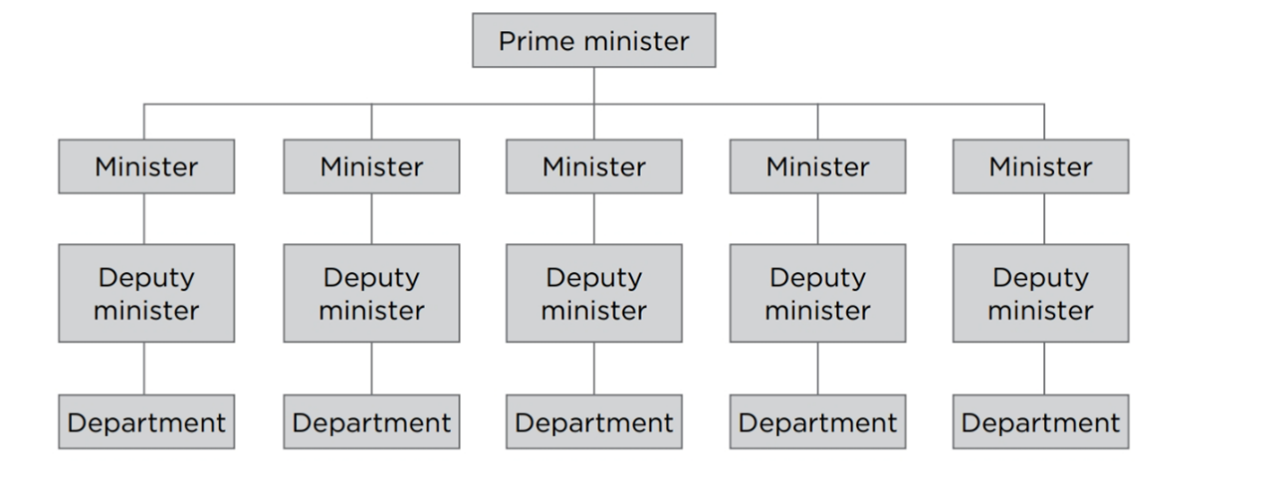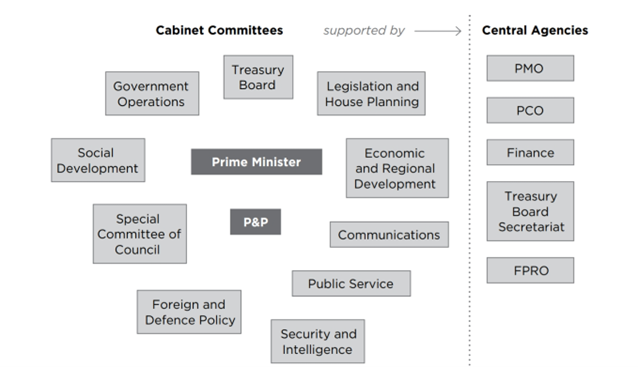Unit 4 - Ministers and Cabinet Decision Making Systems
1/30
Earn XP
Description and Tags
This focused on PM and Ministers (different modes - Trudeau & Harper), and different types (Institutionalized, Departmentalized). Case Study was Justin Trudeau's Government (e.g. gender equality, regional, diverse). Public mandate letters, and opting to change the voting system (from 1st past the post - proportional representation).
Name | Mastery | Learn | Test | Matching | Spaced |
|---|
No study sessions yet.
31 Terms
Deputy Ministers
More senior managers (out of assistant and associate). They are in charge of one of the main functional divisions within a specific department (e.g. operations, finance, personnel or policy). Departments usually have one or two that work closely with the deputy minister on matters. Bigger departments might have 7 to 10.
Return to Cabinet Government
Decision-making power should shift back to the full Cabinet, rather than being concentrated in the Prime Minister and a few advisers.
Centralization
Means concentrating power in fewer hands, usually in the Prime Minister’s Office (PMO) or the Privy Council Office (PCO).
Decentralization
Spreading power more widely across Cabinet and Parliament.
Backbench MPs
Members of Parliament who are not part of Cabinet or the “front bench.” They sit literally on the back benches in the House of Commons chamber. They do not have ministerial responsibilities but they can influence decisions through the Question period, caucus meetings and private members bills.
Central agency
A government body that oversees and coordinates across all departments. Unlike line departments (like Health or Immigration) that focus on their own policy area, central agencies look at the “big picture” for the whole government.
Privy Council Office
Department of Finance
Treasury Board Secretariat
Prime Minister’s Office
Clerk of Privy Council
The top non-partisan civil servant in Canada. Has three major tasks:
Secretary to Cabinet (organizes Cabinet’s work).
Deputy Minister to the Prime Minister (gives advice).
Head of the Public Service (leads all federal civil servants).
Basically, the PM’s #1 bureaucratic advisor and the person who ensures government runs smoothly.
Command-mode
A style of governing where the Prime Minister and central agencies take tight, top-down control over policy and decision-making.
Ministers and departments have less independence compared to a more departmentalized system.
Think of it as the PM “commanding” the machinery of government rather than coordinating more loosely.
Court Government
A term coined by Canadian scholar Donald Savoie.
Describes how power has become centralized around the Prime Minister and their close advisors, similar to a king’s “royal court.” PM and a small group of selected courtiers.
Means that real decision-making often happens in the PMO and PCO, not in the full Cabinet as much.
Suggests Canada has shifted from cabinet government (collective decision-making) to prime ministerial government.
Department of Finance
A regular government department under the category of central agency.
Work it vital to government operations (taxation, budget allocation, deficit and debt).

Departmentalized cabinet system
Individual Ministers / Decentralization
A style of Cabinet where each minister mainly runs their own department independently.
Common in early Canadian history (after 1867).
Decisions were less centralized, with the Prime Minister having less control.
First among equals (PMs formal role)
A phrase often used to describe the Prime Minister’s role in Cabinet.
It means the PM is formally just one minister like the others, but in practice has special authority and influence (appointing ministers, setting the agenda, etc.).

Institutionalized cabinet system
(Structured Committees – Centralization)
A more organized, structured form of Cabinet that developed in the 1960s–80s.
Relies heavily on cabinet committees, rules, and processes to coordinate decisions.
More collective decision-making, but still more structure than the old departmentalized style.
Memorandum to Cabinet
(Document to get Approval)
A formal policy document prepared by a minister (with their department) to ask Cabinet to make a decision.
Lays out the issue, options, costs, risks, and recommended course of action.
Reviewed by cabinet committees and the Privy Council Office before the full Cabinet decides.
Prime Minister’s Office (Parisian Political Staff)
The PM’s political staff (not public servants).
Handles communications, political strategy, media relations, and the PM’s personal agenda.
Staff are partisan. They serve the PM as leader of their party and government.
Privy Council Office (Neutral Civil Service)
The PM’s non-partisan public service support.
Headed by the Clerk of the Privy Council (the top civil servant).
Provides expert, neutral advice; coordinates Cabinet meetings; ensures decisions are carried out.
Priorities and Planning Committee
(Agenda Setting Powerhouse)
One of the most powerful cabinet committees, usually chaired by the Prime Minister.
Sets the government’s overall direction, policy priorities, and controls the flow of issues to Cabinet.
Acts like a gatekeeper for what Cabinet will focus on.
Treasury Board of Canada
Reviews and analyzes the budget of all the departments in detail. This ensures that they fall within spending parameters set by the Department of Finance.
Oversee the general management of the federal public personnel policy (official employer of government personnel, deals with things related to salaries, job classifications, training, etc.).
Treasury Board Secretariat
One of the central agencies of government. It supports the Treasury Board, which is a Cabinet committee of ministers that acts as the government's management board.
The Clerk of Privy Council
Oversees one of the most important organizations. Three main responsibilities:
1. Deputy minister to the PM.
2. Secretary to the cabinet
3. Head of the federal public service
Assistant Deputy Minister
One of the most senior executive officials responsible for providing administrative leadership of a department, such as ADM Finance or ADM Human Resources.
Ranked below associate deputy ministers (also referred to as ADMs) and are usually responsible for a particular functional portfolio within the department.
Case Study: Justin Trudeau Government
Case study where Justin Trudeau demonstrated a gender equal cabinet, that was regionally representative.
This was also when mandate letters were first made public to ensure transparency.
Only 6 had ministerial experience prior.
Included people from different ethnicities.
Responsibility of the Deputy Minister to the Minister (2 Main)
Keep minister out of trouble: Ensure that the department is being managed properly. That things are being done accurately, efficiently and smoothly. Less prelevant mistakes should be dealt with, without the minister.
Assist the minister in the development, cabinet approval and departmental implementation of the policy agenda: Must provide professional and non-partisan policy advice while assisting their ministers in fulfilling the objectives.
Deputy Minister Tasks
1. Administration of policies and programs;
2. Development and assessment of policy initiatives;
3. Liaison and communications
4.Attention to routine departmental needs for financial, personnel and legal administration.
5. Leads managers and their staff by setting priorities;
6. Ensures that senior management have financial, personnel and legal resources necessary to do their jobs effectively.
Formal Cabinet-Decision Making
Process that involves ministers raising issues for Cabinet through general discussion at a Cabinet meeting; or through an advanced notice to the PM or the Privy Council Office (PCO) that serves as the Cabinet secretariat. The latter is more likely to occur.
Active Privy Council
Those cabinet ministers that are actively elected within the current pollical party running the country.
Cabinet
A group of advisors who set and manage the priorities and policy agenda of the government.
A committee of members who are appointed on advice of the PM of the day to the Queen’s Privy Council for Canada by the Governor General of Canada. Held accountable and responsible through Parliament.
Speech from the Throne
Delivered at the opening of a parliamentary session. Sets out broad policy priorities of the government and foreshadow more specific and detailed discussions that the cabinet and committee will make. Correlates to the the agenda that shows the annual budget that comes after.
The Harper Command Mode
Came into power in January 2006.
Emphasized that key priorities were to:
o Support Canadian families and communities;
o Cut taxes;
o Stimulate the economy;
o Restrain the growth of government;
o Promote balanced budgets;
o Rebuild the Canadian Armed Forces;
o Crack down on violence (guns, drugs, gang and crime)
o Promote Canadian sovereignty in the arctic.
The Trudeau (Justin) Command Mode
Came into power in November 2015. Inclusive of a diverse cabinet, making mandate letters public, commitment to progression and conservative values, and promotion of reconciliation with Indigenous peoples.
Major elements of this government included:
Transparency
Accountability
Investing in infrastructure
Climate change
Reconciliation (MMIWG2S Inquiry)
Legalization of weed
First past the post to be changed.
SNC Lavalin Incident
Led to a decrease in Liberal (Trudeau) support.
The SNC-Lavalin affair was a 2019 political controversy in Canada where Prime Minister Justin Trudeau and his office were found to have improperly pressured Attorney General Jody Wilson-Raybould to offer a deal (a deferred prosecution agreement) to SNC-Lavalin, a major Quebec construction firm facing fraud and corruption charges.
Wilson-Raybould resisted, saying it threatened prosecutorial independence. The scandal led to high-profile resignations and an Ethics Commissioner’s ruling that Trudeau had violated conflict-of-interest rules.